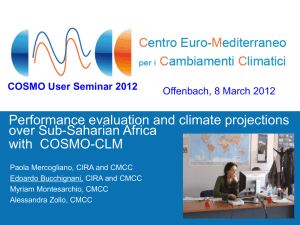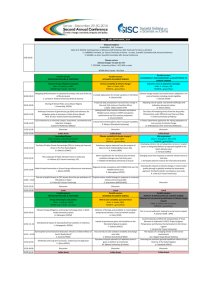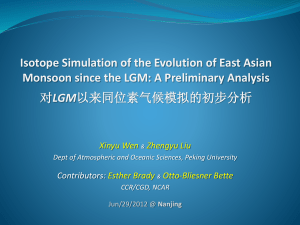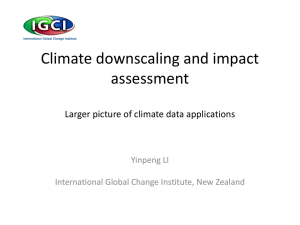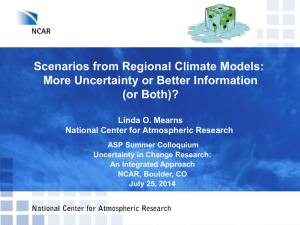CMCC Euro-Mediterranean Centre on Climate Change
advertisement
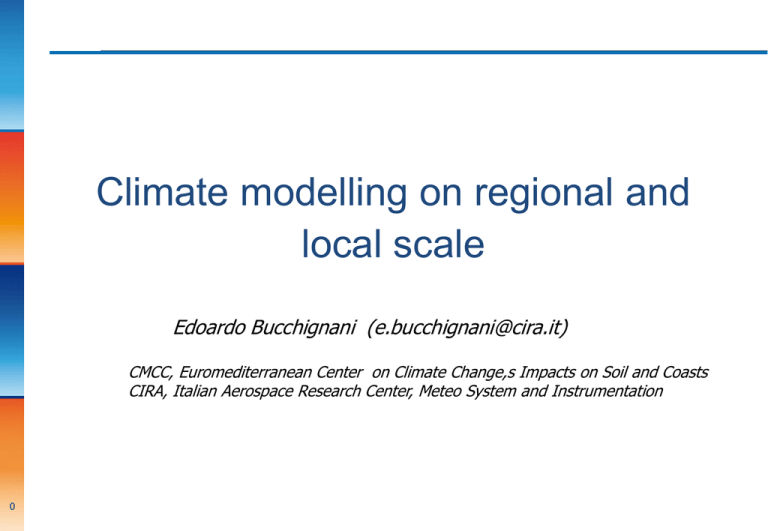
Climate modelling on regional and local scale Edoardo Bucchignani (e.bucchignani@cira.it) CMCC, Euromediterranean Center on Climate Change,s Impacts on Soil and Coasts CIRA, Italian Aerospace Research Center, Meteo System and Instrumentation 0 Outlook • Introduction • Climate Change: an Integrated framework • Global Models and Regional Climate Models • The IPCC scenarios • Dynamical Downscaling • The COSMO – CLM model • Example of climate projections over Africa • Concluding remarks and Discussion Slide 1 CMCC Euro-Mediterranean Centre on Climate Change • CMCC is a non-profit research Institution; • Established in 2005, with the financial support of the Italian Ministry of Education, University and Research and the Ministry of the Environment, Land and Sea; • CMCC manages and promotes scientific and applied activities in the field of international climate change research; • CMCC involves and links private and public institutions jointly investigating multidisciplinary topics related to climate science research; • CMCC offices: Lecce, Bologna, Capua, Milan, Sassari, Venice, Viterbo, Benevento; • CMCC’s mission is to investigate and model our climate system and its interactions with society to provide reliable, rigorous, and timely scientific results to stimulate sustainable growth, protect the environment and to develop science driven adaptation and mitigation policies in a changing climate. Impacts on Soil and Coast (ISC) of CMCC This division has 2 units: • The first Unit focuses on the hydrogeological risks connected with climate change and integrates climate models at the regional scale with the analysis of risks related to extreme events and their impacts (such as landslides, floods and hydrological drought). • The second Unit aims to develop and apply methodologies to analyze environmental impacts and risks correlated with climate change and natural hazards. The team also focuses on the impact of climate change regarding pollution at the regional and global scale in order to identify its potential effects in modifying the bioavailability to toxic chemicals. • ISC Division is also responsible for the development of the regional climate model COSMO CLM. The first unit, in particular, is involved from 2008 in the activities of the CLM Community. • We are currently performing numerical simulations at 0.44o resolution over MENACORDEX domain, driven by ERA-Interim reanalysis for the period 1979-1984, in order to find an optimal configuration of the model. Climate Change – an integrated framework Adaptation Mitigation To Manage the unavoidable To Avoid the unmanageable Slide 4 How can we understand better the Earth system? Observations A numerical laboratory •Experimentation with Earth is not practical •Numerical models of the Earth system allow systematic experimentation •Experimental design making optimal use of the flexibility of the model system under the practical limitations • Easy possibility to run experiments and store data •Diagnostic tools to evaluate the model data Slide 5 The global effort to predict the climate It is possible to predict the climate if we represent the climate system as a set of mathematical equations: the equations of climate. The equations of climate are very complex, but they can be solved in approximate way by numerical techniques: the numerical models of climate. 6 Computational cells: Temperature, Wind, Pressure … Slide 6 Approximations and Assumptions Physical errors: the mathematical model is just a simplified representation of the real world! Numerical errors: governing equations cannot be solved in analytical way, but only through approximate numerical procedures! Moreover, due to the high computational costs for the evaluation of some physical phenomena, the equations “introduced” in the supercomputer must be further simplified (e.g. processes inside clouds, radiative interaction processes, soil-atmosphere interaction processes). 7 Slide 7 The Earth System Models Earth System Model (ESM) comprises several models representing the coupled dynamics, physics and chemistry of the global atmosphere and world oceans ESM Modules •Atmosphere: atmospheric fluid dynamics and thermodynamics, moist processes, radiative transfer, transport and chemistry of trace constituents •Ocean World: ocean circulation, ocean biogeochemistry •Land surface: Surface processes, ecosystems, hydrology •Ocean surface: Sea ice, wave processes. Slide 8 ESM in Europe Center Country Atmosphere Atm-Strat ocean sea ice coupler land sfc atmos ocean chem biogeochem PISCES IPSL France LMD NEMO NEMO/LIM OASIS3 ORCHIDEE INCA CNRM France ARPEGE NEMO GELATO OASIS ISBA-A-gs MOCAGE Hadley (GEM2) UK UM NEMO CICE OASIS Hadley (GEM3) UK UM NEMO CICE OASIS JULES UKCA ECHAM5 MPI-OM EcBilt CLIO CLIO ECHAM5 NEMO LIM OASIS3 NEMO/LIM OASIS Cerfacs NERC UK COSMOS Germany OASIS MESSy HAMMOZ Finland Sweden LOVECLIM Belgium CMCC Italy DMI Danemark IFS/ARP/ECHAM NEMO NL IFS NEMO NCAR MICOM NCAR/CICE GISS GISS VECODE LOCH SILVA PELAGOS OASIS4 NCAR HAMOCC GISS GISS EC-EARTH KNMI OASIS ECMWF SMHI Sweden Ireland Switzerland Danemark Portugal Bjerknes Norway NERSC Norway BSC Spain CAPC Greece NCAR/GISS GISS developed under devt GISS GISS Slide 9 The CMCC coupled atmosphere-ocean G C M ATMOSPHERE (dynamics, physics, prescribed gases and aerosols) Global Atmosphere ECHAM5 T159 (~ 80Km ) - L31 Roeckner et al. (2006) Heat Flux Mass Flux Momentum Flux SST SS vel. Global Ocean & Sea-Ice COUPLER Oasis 3 Valcke et al. (2004) OCEAN (dynamics and physics) OPA (Barnier et al. 2006) SEA-ICE: LIM (Timmermann et al. 2005) Slide 10 The IPCC Scenarios A plausible description of how the future may develop, based on a coherent and internally consistent set of assumptions about key relationships and driving forces (e.g., rate of technology changes, prices). Note that scenarios are neither predictions nor forecasts. These scenarios describe several factors associated with climate change in the XXI century. These factors include emission levels for 10 greenhouse gases, regions’ economic viability, energy technology in use, resources in use, land use, and carbon sequestration rates. Marmolada, begin of XIX century Marmolada today Slide 11 Radiative forcing It is a measure of the influence of these factors in altering the balance of incoming and outgoing energy in the Earth - atmosphere system and is an index of the importance of the factors as a potential climate change mechanism. IPCC 5th Coupled Model Intercomparison project (CMIP5) Slide 12 CMPI5: Representative Concentration Pathways (RCP) RCP8.5: high emissions scenario, high population growth, slow per capita income growth, little convergence by high and low countries; coal intensive energy scenario RCP4.5: high income growth, low population growth, gains in clean energy and efficiency resulting from aggressive carbon pricing ($85/ton CO2 by 2100) Carbon Dioxide and Methane concentration time series used to force the atmospheric component of the CMCC CGCM model according to the different scenarios. Slide 13 CMCC IPCC Experiments: Global mean surface temperature anomaly. Slide 14 The CMCC global simulations: T2M changes RCP8.5: T2m at the end of the 21st century might be larger than 3.5 °C with respect to the Slide 15 reference period. The CMCC global simulations: Total Precipitation changes Projected changes in precipitation are less linear. The projected increase in the central part of Africa (up to 60%,) is more pronounced and extended northward in A1B scenario if compared to the other ones. Slide 16 Precipitation Projections: consistency with other global models CMCC Slide 17 Global changes, local changes: the problems of downscaling Slide 18 Reasons why downscaling of GCM output is useful • There are important differences between the real world and its model representation; • small-scale effects (such as topography) important to local climate could be poorly represented in the GCM; • variables such as streamflow may not be represented explicitly by the GCM; • GCMs are not perfect and their forecasts are subject to error (i.e., parameterization schemes are not perfect); • Impact models need high resolution data. 19 Slide 19 Downscaling Definitions Simulation of climate sub-grid-scale based on output from global climate models. It can be performed: by developing a statistical relationship between local climate variables and model predictors (large scale variables). Statistical downscaling by explicit solving of processbased physical dynamics of the regional climate system. Dynamical downscaling 20 Slide 20 The simulation cascade Cascade Forecasts • Global Models (GCM) – Require initial conditions – Low horizontal and vertical resolution • Regional Climate Models (RCM) – Require Boundary conditions (by GCM) – High resolution and nesting • Specific high resolution models Example: specific models for the reconstruction of a wind field on complex orographic areas 21 Slide 21 Global Circulation Model vs Limited Area Model Orography 22 Slide 22 The COSMO CLM REGIONAL MODEL The regional model used for the simulations is COSMO-CLM (1-50 km of horizontal resolution) 23 Slide 23 Overview • The COSMO-CLM is the Climate Mode of the COSMO model system: • It is a non hydrostatic regional climate model atmospheric prediction system, developed by the CLM-Community. •It is designed for simulations on time scales up to centuries and spatial resolutions down to 1 km. • It is the only limited area numerical model system in Europe which has a range of applicability encompassing: 1. 2. 3. 4. operational numerical weather prediction (COSMO) regional climate modelling of past, present and future (CLM), the dispersion of trace gases and aerosol (ART) and idealized studies (ITC) • It is applicable for downscaling in all regions of the world and of most of the Global Climate simulations available • It is fully documented. • it is freely available for scientific purposes Slide 24 COSMO-CLM: Overview A huge variety of applications of the model system exists within more than 300 scientific projects in the field of regional climate modelling covering: • high resolution simulations of mega-cities • medium resolution simulations of continents • tropical to arctic latitudes • paleo studies, the recent past and climate scenarios for the 21st century. This makes it highly relevant for climate science and for climate mitigation and adaptation politics. However, the development of a fully dynamical reliable regional earth system model is still ongoing. Slide 25 Why a non-hydrostatic model for weather and climate ? Better description of convective phenomena with respect to hydrostatic models (the convective rain is characterized by localized and intense rainstorm) •Challenges of NWP - Local accuracy for agriculture, industry and society -Prediction of extreme weather events •Challenges of RCM - Climate and climate change of vulnerable regions for climate application studies - Climate Change of extreme event statistics Slide 26 Climate models need to be further developed Snow or Rain? Winter-sport regions need reliable predictions Salzburg, 2011 Parameterizations The governing equations are not sufficient in order to give a complete description of the phenomena that take place in the atmosphere. Some phenomena, take place on unresolved motion scales, but they have significant impact also on the scale of meteorological impact. Examples: turbulent diffusion in the atmosphere, interaction with the orography, convection. In order to improve the quality of the previsions of model, the effects of these phenomena are taken into account by means of PARAMETERIZATIONS. Slide 27 The CMCC work plan Study of the climate of Lebanon Collection and analysis of the available data Set up of the regional climate model on the region of interest Climate simulation related to a past period (e.g. 1979-2011) (1994) Validation with available observations (e.g. CRU dataset) Execution of the climate projections for the period 2006 - 2100, employing the IPCC RCP4.5 and RCP8.5 emission scenarios Evaluation of : rainfall probability curves (format utilizable by hydrologist), seasonal cycle of surface temperature and extreme climate indices. Bias correction (if needed) Slide 28 IBM Power6 supercomputer Architecture: Cluster of 30 IBM P575 nodes Configuration: 30 Nodes Each node has 32 (4.7 GHz) cores and 128 GB of memory 18 Tflops computing power Infiniband 4x DDR interconnection Operating system: AIX 5.3 Compilers: Fortran90, C/C++ Slide 29 IBM High Performance Computing system Architecture: Cluster of INTEL Sandy Bridge processors Xeon E5-2670 2,6 GHz Configuration: 482 bi-processor iDataplex dx360 M4 computing nodes FDR InfiniBand network (56Gb/sec) interconnection The theoretical peak performance of the system (7712 cores in total) is about 160Tflops Operating system: CentOS v.6.2 ( Linux kernel ) Compilers: Fortran90, C/C++ Slide 30 Climate projections over over SubSaharian Africa 2021-2050 vs. last thirty years of the XX century. Simulations performed at 8 km resolution, driven by CMCC-MED (80 km resolution). Slide 31 T2m : future (2021-2050) vs past (1971-2000) RCP4.5 DJF Less evident increase of temperature, especially in JJA. In DJF, significant increase in the northern part. JJA Slide 32 T2m : future (2021-2050) vs past (1971-2000) RCP8.5 DJF Larger increase of temperature in JJA with respect to the other scenario. In DJF, the increase is evident only in the northern part. JJA Slide 33 Precipitation: future (2021-2050) vs past (1971-2000) RCP4.5 There are differences between the two seasons. In DJF, there is a general increase of precipitation, while in JJA there is a summer there is a general increase with some exceptions. Slide 34 DJF JJA Precipitation: future (2021-2050) vs past (1971-2000) RCP8.5 In DJF, there is a general increase of precipitation, similar to RCP4.5 DJF In JJA there is a behavior similar to RCP4.5 JJA Slide 35 T2m and precipitation Trend (A1B vs RCP 4.5) Ouagadougou St.Louis Slide 36 Thank you for your attention e.bucchignani@cira.it

